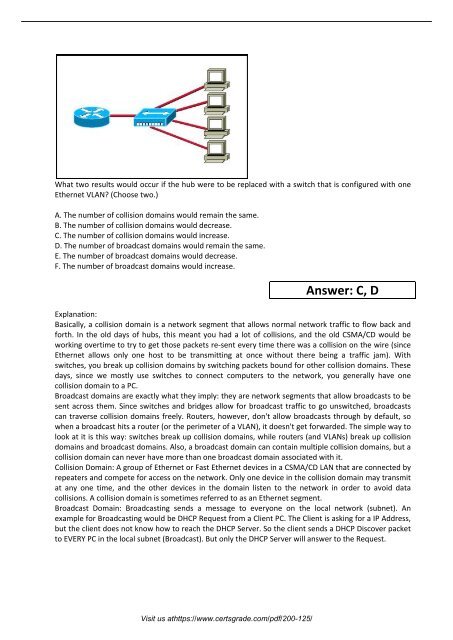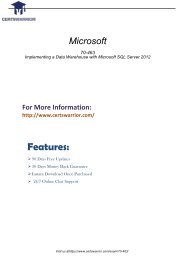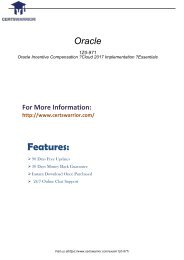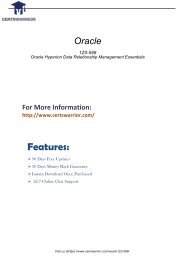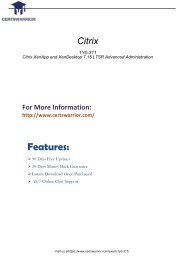200-125 Study Material
We offer you free sample questions along answers prepared by the professionals of the IT field. You can easily pass your 200-125 Test with our Training Kits. For more info please visit here: http://www.certsgrade.com/pdf/200-125/
We offer you free sample questions along answers prepared by the professionals of the IT field. You can easily pass your 200-125 Test with our Training Kits. For more info please visit here: http://www.certsgrade.com/pdf/200-125/
You also want an ePaper? Increase the reach of your titles
YUMPU automatically turns print PDFs into web optimized ePapers that Google loves.
What two results would occur if the hub were to be replaced with a switch that is configured with one<br />
Ethernet VLAN? (Choose two.)<br />
A. The number of collision domains would remain the same.<br />
B. The number of collision domains would decrease.<br />
C. The number of collision domains would increase.<br />
D. The number of broadcast domains would remain the same.<br />
E. The number of broadcast domains would decrease.<br />
F. The number of broadcast domains would increase.<br />
Answer: C, D<br />
Explanation:<br />
Basically, a collision domain is a network segment that allows normal network traffic to flow back and<br />
forth. In the old days of hubs, this meant you had a lot of collisions, and the old CSMA/CD would be<br />
working overtime to try to get those packets re-sent every time there was a collision on the wire (since<br />
Ethernet allows only one host to be transmitting at once without there being a traffic jam). With<br />
switches, you break up collision domains by switching packets bound for other collision domains. These<br />
days, since we mostly use switches to connect computers to the network, you generally have one<br />
collision domain to a PC.<br />
Broadcast domains are exactly what they imply: they are network segments that allow broadcasts to be<br />
sent across them. Since switches and bridges allow for broadcast traffic to go unswitched, broadcasts<br />
can traverse collision domains freely. Routers, however, don't allow broadcasts through by default, so<br />
when a broadcast hits a router (or the perimeter of a VLAN), it doesn't get forwarded. The simple way to<br />
look at it is this way: switches break up collision domains, while routers (and VLANs) break up collision<br />
domains and broadcast domains. Also, a broadcast domain can contain multiple collision domains, but a<br />
collision domain can never have more than one broadcast domain associated with it.<br />
Collision Domain: A group of Ethernet or Fast Ethernet devices in a CSMA/CD LAN that are connected by<br />
repeaters and compete for access on the network. Only one device in the collision domain may transmit<br />
at any one time, and the other devices in the domain listen to the network in order to avoid data<br />
collisions. A collision domain is sometimes referred to as an Ethernet segment.<br />
Broadcast Domain: Broadcasting sends a message to everyone on the local network (subnet). An<br />
example for Broadcasting would be DHCP Request from a Client PC. The Client is asking for a IP Address,<br />
but the client does not know how to reach the DHCP Server. So the client sends a DHCP Discover packet<br />
to EVERY PC in the local subnet (Broadcast). But only the DHCP Server will answer to the Request.<br />
Visit us athttps://www.certsgrade.com/pdf/<strong>200</strong>-<strong>125</strong>/


